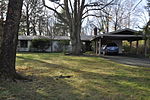Marcel Breuer House II
Houses completed in 1947Houses in New Canaan, ConnecticutMarcel Breuer buildingsModernist architecture in ConnecticutNational Register of Historic Places in Fairfield County, Connecticut

The Marcel Breuer House II, also known as the New Canaan Breuer House I, is a historic house at 122 Sunset Hill Road in New Canaan, Connecticut. Built in 1947, it was designed by architect Marcel Breuer as a home for his family. It is an important early example of his Modern Movement designs, with a cantilevered design featuring glass and stone finishes. The house, occupied by his family for just four years, was listed on the National Register of Historic Places in 2010.
Excerpt from the Wikipedia article Marcel Breuer House II (License: CC BY-SA 3.0, Authors, Images).Marcel Breuer House II
Sunset Hill Road,
Geographical coordinates (GPS) Address Nearby Places Show on map
Geographical coordinates (GPS)
| Latitude | Longitude |
|---|---|
| N 41.155833333333 ° | E -73.506944444444 ° |
Address
Sunset Hill Road 133
06840
Connecticut, United States
Open on Google Maps









